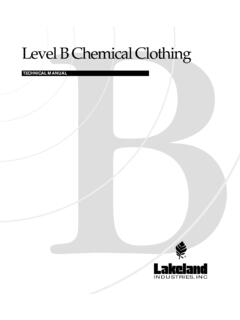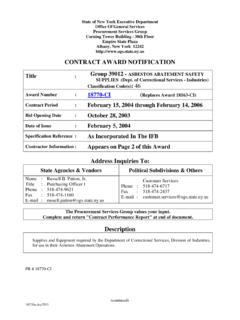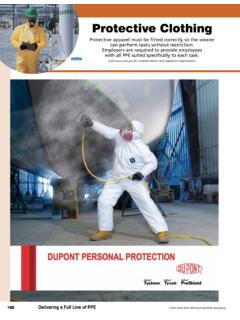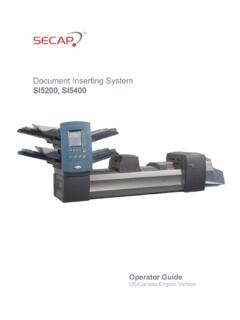Transcription of Guidance for Selection of Protective Clothing for MDI Users
1 Table of ContentsISSUE AX178 MARCH 2013 Guidance for Selection of Protective Clothing for MDI UsersPurposeThe purpose of this document is to provide useful Guidance for selecting the appropriate personal Protective equipment (PPE) for working with methylene diphenyl diisocyanate (MDI) and to analyze the performance characteristics of several gloves, coveralls, splash suits, and other Protective garments commonly used when working with MDI and polymeric MDI (PMDI).[1] MDI is a solid white to yellow flake at room temperature; however, it can be sold in a heated (molten) form when it is in a liquid state. PMDI is a liquid at room temperature and typically is a mixture of monomeric forms of MDI (2,4 and 4,4-MDI) and higher molecular weight oligomers of and Safety Protection and Respiratory Protective for Selection of Protective Clothing for MDI Users Health and Safety Information During the handling, processing, and application of MDI/PMDI, contact with vapor, liquid, or aerosol/mist may cause adverse health effects to the skin, eyes, and respiratory system.
2 Inhalation of MDI vapors or aerosol/mist at concentrations above the occupational exposure limit ( , ACGIH-TLV or OSHA PEL) can irritate the respiratory system (nose, throat, lungs) causing runny nose, sore throat, coughing, chest discomfort, shortness of breath, or reduced lung function. Persons with a pre-existing condition, non-specific bronchial hyper-reactivity, can respond to airborne concentrations below the TLV or PEL with similar symptoms as well as an asthma attack or asthma-like symptoms. As a result of previous repeated overexposures (above the TLV or PEL) or a single large dose, certain individuals may develop sensitization to diisocyanates (asthma or asthma-like symptoms) that may cause them to react to a later exposure to diisocyanates at levels well below the threshold limit value (TLV) or permissible exposure limit (PEL).
3 Direct skin contact with MDI/PMDI may cause irritation with symptoms of reddening, swelling, rash, and, in some cases, skin sensitization. Animal tests and other research indicate that skin contact with MDI can play a role in causing sensitization and respiratory reaction. Engineering controls ( local exhaust ventilation) and sound workplace practices may be the first line of defense against potential exposure to MDI/PMDI, and guidelines have been established by OSHA to help individuals avoid overexposure and adverse health effects1. It is important that employees wear PPE recommended for their specific job functions to prevent direct skin/eye contact with PMDI liquid or inhalation of MDI vapors/mist.
4 Eye Protection and Respiratory Protection In addition to the gloves and garments analyzed later in this bulletin, individuals working with MDI and PMDI containing products need to consider the use of appropriate eye, face, and respiratory protection. Eye Protection In situations where there is splash potential ( , when directly handling liquid product), wear chemical goggles and, depending on the extent of potential contact, a faceshield. These situations may include line-breaking (transfer hose disconnect), transfer of material using a drum pump, etc. MDI may irritate the eyes and can be difficult to remove, so prevention is very important. Respiratory Protection Airborne MDI concentrations greater than the ACGIH TLV or OSHA PEL can occur in inadequately ventilated environments when MDI is sprayed, aerosolized, or heated.
5 In such cases, wear respiratory protection. The type of respiratory protection selected must comply with the requirements set forth in OSHA s Respiratory Protection Standard (29 CFR ). The use of air purifying respirators (APRs) is acceptable in certain situations as part of a comprehensive respiratory protection program2. An organic vapor cartridge with a particulate filter ( OV/P100) may be used with the APR where the concentration of MDI in air can be documented and where the protection factor will not be exceeded. A cartridge change out schedule is required to be part of the respiratory protection program by OSHA. When concentrations of MDI exceed or are likely to exceed the protection afforded by a cartridge respirator ( emergency situations or identified high exposure potential activities), a supplied-air respirator (SAR) is necessary under OSHA s standard.
6 1 For details, see CPI Guidance Document AX205, Working With MDI and Polymeric MDI: What You Should Know, available at 2 For more details on the use of air purifying respirators under the OSHA Standard, please refer to Guidance Document AX 246, CPI Model Respiratory Protection Program for Compliance With the Occupational Safety and Health Administration Respiratory Protection Standard 29 CFR available at Guidance for Selection of Protective Clothing for MDI Users Selecting Protective Clothing Understand and adhere to safe handling practices for MDI/PMDI and other chemicals that pose potential health hazards.
7 This may include wearing eye protection, respiratory protection, gloves, boots and coveralls or lab aprons. For individuals who work with MDI/PMDI, appropriate Protective Clothing is essential for the prevention of skin exposures. When selecting Protective Clothing , consider the following factors: Chemical Resistance of Glove or Garment: To be effective, the Protective Clothing should resist permeation by the chemical or chemicals being handled. Use of disposable gloves and Clothing is often preferred, because proper decontamination of reusable items may be difficult. Protective gloves and garments should also be resistant to permeation by solvents used in combination with MDI/PMDI.
8 Specific Job Functions: The nature of the job being performed will greatly influence the Selection and features of Protective Clothing . For example, analyzing foam samples in a laboratory may require light-duty gloves (<10 mils in thickness) that are flexible and preserve manual dexterity; on the other hand, a maintenance project, such as repairing a pump line, may require thicker gloves that are rugged and durable. When the manual dexterity requirements of some jobs require the use of thin, form-fitting gloves that offer limited amounts of protection time, change the gloves with sufficient frequency. Potential for Exposure: The degree of exposure for individual job functions dictates the degree of personal protection required and the appropriate Clothing for the job.
9 For instance, work conducted in a laboratory environment, where the potential for exposure to the skin and eyes is limited, may need gloves, eye protection, and a lab apron or lab coat. On the other hand, a project that presents a greater risk of acute exposure to the skin and eyes, such as loading and unloading tank cars, may need to use hooded coveralls, boots, and more substantial gloves (heavy duty and light duty) to ensure adequate protection. Duration of Exposure: The length of time that an individual is working with or handling MDI/PMDI influences the type of Protective Clothing selected. When working with MDI for extended time periods, Protective Clothing that offers the greatest level of chemical resistance is appropriate.
10 In addition to these factors, individual work habits, industrial hygiene practices, and pre-existing workplace procedures and controls will influence decisions made when selecting Protective Clothing . Research Approach The International Isocyanate Institute (III) sponsored a study in which Texas Research Institute (TRI) evaluated materials from more than 50 items of chemical Protective Clothing 35 gloves of 10 different materials and 17 suits of 14 different materials to determine the degree of resistance to permeation offered by each garment. The III research measured the length of time it took polymeric MDI (PMDI) to permeate through the Protective Clothing material under conditions of continuous contact and complete surface coverage with PMDI.










